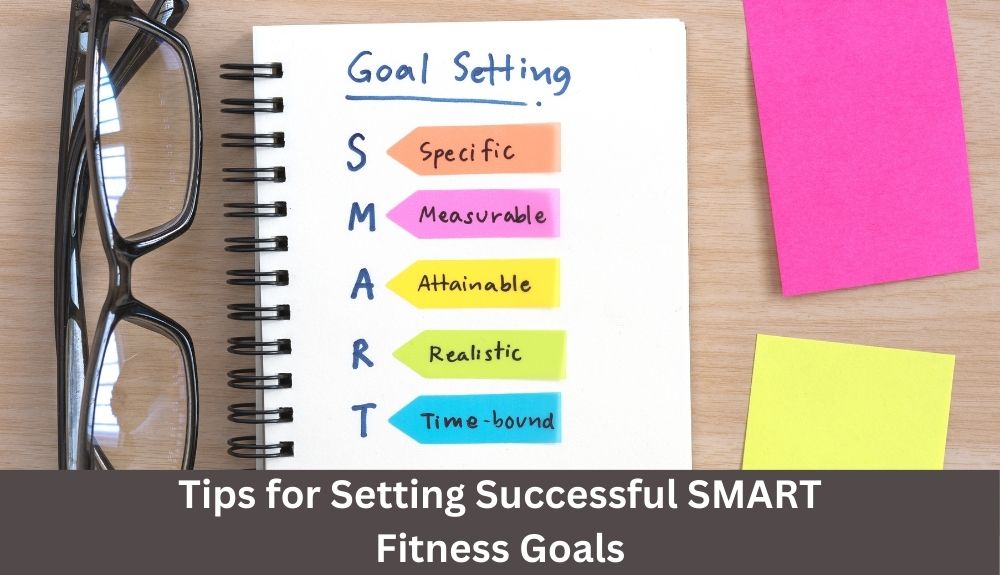Are you tired of starting a fitness routine, only to lose motivation and give up after a few weeks? Do you find yourself struggling to stay committed to your health and wellness goals? If so, don’t worry – you’re not alone. Many people face challenges when it comes to maintaining long-term motivation for their fitness journey.
One key factor that can make all the difference is setting SMART fitness goals. By incorporating this simple yet effective framework into your goal-setting process, you’ll be equipped with the tools and mindset needed to stay focused, track progress, overcome obstacles, and achieve lasting success.
In this blog post, we will delve into the importance of setting goals in fitness and introduce the concept of SMART goals. We will explore each element of the SMART acronym – Specificity, Measurability, Attainability, Relevance, and Time-Bound – providing practical tips along the way. So grab a pen and paper (or open up that note-taking app), because it’s time to take control of your fitness journey like never before!
The Importance of Setting Goals in Fitness
Have you ever embarked on a fitness journey without a clear destination in mind? It’s like setting sail on a ship with no map or compass – you might end up drifting aimlessly, unsure of where you’re going. Setting goals in fitness is crucial because it provides direction and purpose to your efforts.
Goals serve as the guiding light that keeps us motivated and focused on our desired outcome. Whether your goal is to lose weight, build muscle, improve endurance, or simply lead a healthier lifestyle, having a specific target gives you something tangible to work towards.
Moreover, setting goals allows us to track our progress along the way. When we have measurable objectives in place, we can monitor how far we’ve come and celebrate each milestone achieved. This sense of accomplishment fuels our motivation and propels us forward.
Setting goals also helps us stay accountable. By committing your intentions to paper (or typing them into your phone), you are making a conscious commitment to yourself. You’re more likely to stay dedicated when you have concrete targets staring back at you.
Furthermore, goals provide clarity amidst the chaos of everyday life. With so many distractions pulling us in different directions, it’s easy for our health and wellness aspirations to take a backseat. However, by establishing clear goals that align with our values and priorities, we gain clarity about what truly matters most – ourselves and our well-being.
Introduction to SMART Goals
When it comes to achieving success in fitness, setting goals is crucial. But not just any goals – SMART goals! This acronym stands for Specific, Measurable, Attainable, Relevant, and Time-Bound. Let’s dive into each aspect of SMART goal setting and how it can help you stay motivated on your fitness journey.
Specificity is key when setting fitness goals. Rather than saying “I want to get fit,” be specific about what that means to you. Is it running a 5k race or being able to do 10 push-ups? Defining your goal gives you something concrete to work towards.
Measurability allows you to track your progress along the way. Set benchmarks or milestones that will indicate whether you are moving closer to your ultimate goal. Whether it’s tracking your weight loss or measuring the distance you can run without stopping, having measurable targets keeps you accountable.
Attainability is all about setting realistic and achievable goals. It’s important not to bite off more than you can chew because this can lead to frustration and disappointment if expectations are too high. Start with small wins that build confidence and gradually increase the difficulty as you progress.
Relevance involves aligning your fitness goals with what truly motivates and matters to YOU personally. Maybe improving cardiovascular health will allow you more energy for playing with your kids or participating in activities that bring joy – whatever drives YOU should be at the forefront of goal-setting decisions.
Time-bound components create a sense of urgency and give structure by providing a deadline for achievement. Setting target dates keeps us focused on taking consistent action rather than procrastinating indefinitely.
By following these principles of SMART goal-setting – specificity, measurability, attainability relevance and time-bound deadlines –you’ll have a powerful tool at hand for staying motivated on your fitness journey.
Specificity: Defining Your Fitness Goal
When it comes to setting fitness goals, being specific is key. It’s not enough to say you want to “get in shape” or “lose weight.” To stay motivated and focused, you need a clear target to aim for.
Start by asking yourself what exactly you want to achieve. Do you want to run a marathon? Build muscle? Improve your flexibility? The more specific you can be, the better.
Once you have determined your overall goal, break it down into smaller milestones. For example, if your goal is to run a marathon, set smaller targets like increasing your weekly mileage or improving your pace.
Defining the specifics of your fitness goal will help keep you on track and give you something tangible to work towards. It also allows for better planning and accountability.
Remember that everyone’s goals are unique. What works for someone else may not necessarily work for you. That’s why it’s important to personalize your goals based on factors such as age, fitness level, and lifestyle constraints.
By clearly defining your fitness goal with specificity, you’ll have a clear roadmap towards success and be more likely to stay motivated throughout the journey!
Measurability: Tracking Progress and Success

When it comes to fitness goals, tracking your progress and measuring success is essential. Setting measurable goals allows you to have a clear understanding of where you currently stand and helps you track your progress over time. It provides a tangible way to see how far you’ve come and keeps you motivated along the way.
One effective method for measuring progress is by using specific metrics such as weight, body measurements, or performance benchmarks. By regularly tracking these metrics, you can objectively assess whether or not you’re making progress towards your fitness goals.
Another valuable tool for measuring success is keeping a workout journal or utilizing fitness apps that allow you to record your workouts and track your performance. This not only helps with accountability but also enables you to identify patterns and trends in your training routine.
In addition to objective measures, it’s important to pay attention to subjective indicators of progress such as improved energy levels, increased stamina, or better sleep quality. These qualitative aspects are equally important in assessing overall well-being and should not be overlooked.
Remember that everyone’s journey is unique, so don’t compare yourself too much with others. Focus on celebrating small victories along the way rather than solely fixating on long-term results. Tracking progress allows for adjustments when necessary while providing motivation through visible improvements.
By incorporating measurability into goal setting practices, individuals can establish realistic expectations while staying engaged with their fitness journey!
Attainability: Setting Realistic and Achievable Goals
When it comes to setting fitness goals, one of the most important factors to consider is attainability. It’s easy to get caught up in the excitement of wanting to achieve big, ambitious goals, but if they’re not realistic or achievable, it can lead to frustration and disappointment.
Setting realistic goals means taking into account your current fitness level, lifestyle constraints, and any potential obstacles that may arise along the way. It’s essential to be honest with yourself about what you can realistically accomplish given your circumstances.
By setting attainable goals, you set yourself up for success. Start by breaking down your larger fitness goal into smaller milestones that are more manageable and easier to achieve. This allows you to track your progress and celebrate each small victory along the way.
Remember that everyone’s journey is unique, so don’t compare yourself to others or feel pressured by societal standards. Focus on what feels right for YOU and what aligns with YOUR personal values and motivation.
Additionally, seeking support from a professional trainer or joining a supportive community can help keep you accountable and motivated throughout your fitness journey.
While it’s great to dream big when setting fitness goals, it’s crucial also set realistic ones that are achievable within your current circumstances. Embrace the process of working towards these goals step by step rather than fixating solely on the end result. By doing so, you’ll increase your chances of long-term success and maintain motivation along the way!
Relevance: Aligning Goals with Personal Values and Motivation
When it comes to setting fitness goals, it’s crucial to align them with your personal values and motivation. What drives you? What gives you a sense of purpose in your fitness journey?
One way to ensure that your goals are relevant is by understanding why they matter to you. Perhaps you want to improve your overall health because you value longevity and quality of life. Or maybe you’re motivated by the desire to feel more confident and comfortable in your own skin.
By identifying the underlying values behind your goals, you’ll find greater meaning in pursuing them. This deeper connection will serve as a constant reminder of why these objectives are important to you.
Moreover, aligning goals with personal values enhances intrinsic motivation – the internal drive that comes from within. When our goals resonate with our core beliefs and desires, we experience an innate passion for achieving them.
It’s also essential not to compare yourself or adopt someone else’s definition of success. Stay true to what matters most to YOU! Your journey is unique, and so should be your aspirations.
Remember that relevance is not just about choosing meaningful objectives; it’s also about staying committed when challenges arise along the way. By anchoring yourself in what truly matters, setbacks become opportunities for growth rather than reasons for giving up.
So take some time reflecting on what fuels your fire and use that energy as fuel for setting relevant fitness goals tailored specifically for YOU!
Time-Bound: Creating a Deadline for Achievement
One of the key elements of setting SMART fitness goals is ensuring they are time-bound. By establishing a specific deadline for achieving your goal, you create a sense of urgency and motivation to stay on track.
When it comes to fitness, having a timeline helps keep you focused and accountable. Without one, it’s easy to fall into the trap of procrastination or lose sight of your progress. Setting an end date gives you something concrete to work towards and allows you to measure your success along the way.
Whether it’s completing a 5k run in three months or losing 10 pounds within six weeks, having a time-bound goal provides structure and direction. It acts as a roadmap guiding your actions and keeping you disciplined throughout your fitness journey.
However, it’s important to be realistic when setting deadlines for yourself. Make sure they are achievable given your current level of fitness, lifestyle constraints, and any other commitments you may have. Pushing yourself too hard with unrealistic timelines can lead to burnout or injury.
To ensure success with time-bound goals, break them down into smaller milestones that serve as stepping stones towards the ultimate achievement. This allows you to track progress regularly and make any necessary adjustments along the way.
Remember that everyone progresses at their own pace; don’t compare yourself to others or get discouraged if things take longer than expected. The focus should always be on continuous improvement rather than rushing towards an arbitrary finish line.
By creating deadlines for achievement in your fitness journey, you establish clear targets that provide motivation and direction. Embrace this aspect of goal-setting as an opportunity for growth rather than added pressure. Stay committed, celebrate small victories along the way, and embrace the transformative power of setting time-bound goals in shaping lasting change.
Tips for Setting Successful SMART Fitness Goals

1. Start with a clear vision: Before setting your fitness goals, take some time to envision what you want to achieve. Think about how you want to feel, the changes you want to see in your body, and the overall impact on your life. This will give you a strong foundation to build upon.
2. Break it down: Instead of overwhelming yourself with one big goal, break it down into smaller, more manageable steps. For example, if your ultimate goal is to run a marathon, start by aiming for a 5K race first and gradually work your way up. This will make the process less daunting and help you stay motivated along the way.
3. Stay specific: Be as specific as possible when defining your fitness goals. Rather than saying “I want to get fit,” try something like “I want to be able to do 10 full push-ups without stopping.” Specific goals provide clarity and direction.
4. Make it measurable: Set measurable milestones that allow you to track your progress effectively. Whether it’s tracking the number of reps or inches lost, having quantifiable markers helps keep you accountable and provides motivation as you witness tangible results.
5. Keep it realistic: It’s important to set goals that are both challenging yet attainable within a reasonable timeframe given your current fitness level and lifestyle commitments.
6. Align with personal values: Your fitness goals should align with what truly matters most in your life – whether that’s improving health conditions or being able to play actively with children/grandchildren.
7. Set deadlines: Establishing deadlines can add urgency and structure which helps prevent procrastination while giving focus on achieving timely results.
8. Track progress regularly : Regularly tracking progress gives insight into areas where adjustments may be needed in order maintaining momentum towards reaching desired outcome(s).
9. Seek support from others : Surround yourself with individuals who motivate, inspire on journey helping stay on track, share struggles and celebrate achievements. They can be friends, family members
Overcoming Obstacles and Staying Motivated
Setting SMART fitness goals is a powerful tool for long-term motivation. However, even with the best intentions and well-defined goals, obstacles can arise that threaten to derail our progress. It’s important to have strategies in place to overcome these challenges and stay motivated on our fitness journey.
One of the key factors in overcoming obstacles is having a strong support system. Surround yourself with like-minded individuals who share your passion for fitness or enlist a workout buddy who can hold you accountable and provide encouragement when things get tough.
Another effective strategy is to break down your larger goal into smaller, more manageable tasks. This not only makes your goal less intimidating but also allows you to track your progress more effectively along the way. Celebrate each milestone reached, no matter how small, as it will keep you motivated and give you the confidence to continue pushing forward.
It’s also important to remember that setbacks are inevitable. Life happens! Don’t let minor setbacks discourage you or make you question your abilities. Instead, view them as opportunities for growth and learning. Adjust your approach if necessary but never lose sight of why you started in the first place.
Finding ways to inject variety into your workouts can also help combat boredom or loss of motivation. Try new exercises, explore different types of training such as HIIT or yoga classes, or join group activities like sports leagues or running clubs. By keeping things fresh and exciting, you’re more likely to stick with it long term.
Be kind to yourself throughout this journey. Remember that Rome wasn’t built in a day and neither will achieving your fitness goals be an overnight success story! Treat yourself with compassion during times of frustration or when progress seems slow – because every step counts towards becoming a healthier version of yourself.





















